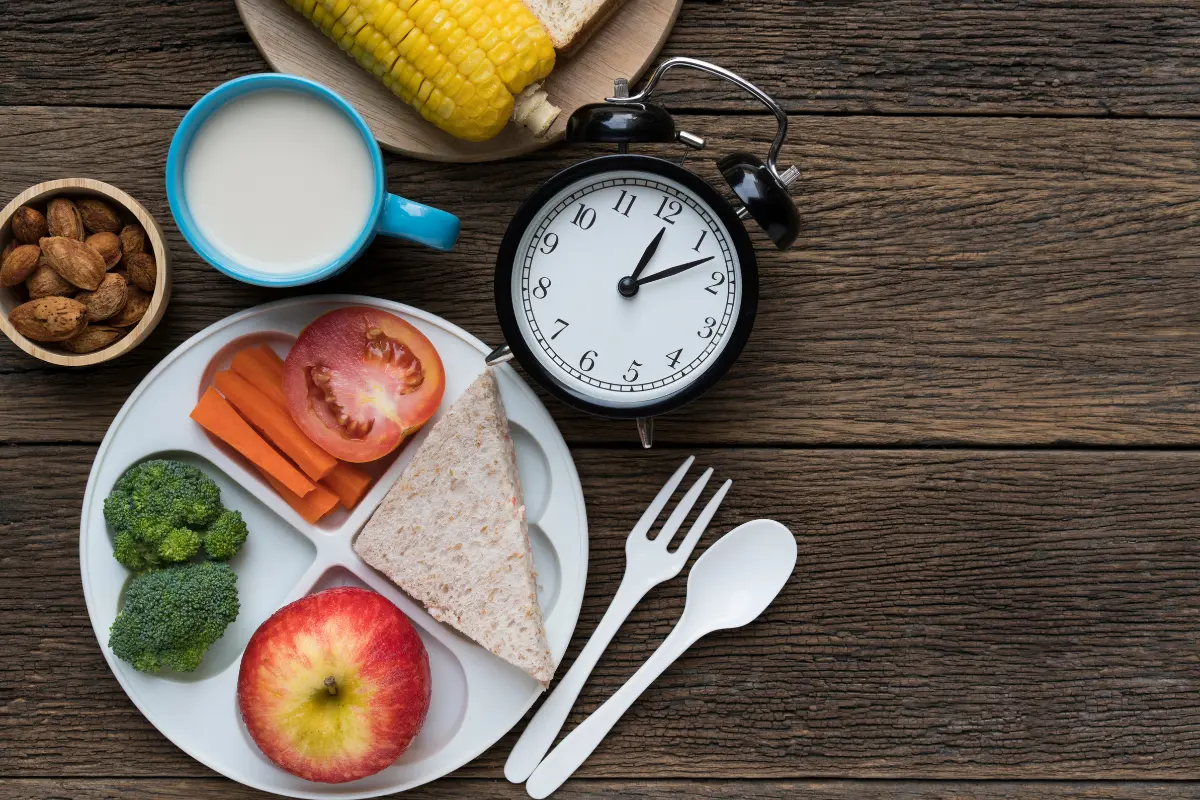
You dedicate time to planning your workouts and pushing your limits in the gym, but are you strategically planning when you fuel your body? While what you eat is crucial, when you eat can have a significant impact on your results.
Understanding meal timing benefits is key to unlocking better performance during your sessions and faster recovery afterward. It's not just about calories in vs. calories out; strategically timing your nutrient intake, particularly carbohydrates and protein, can influence everything from energy availability and muscle breakdown to glycogen replenishment and muscle growth. This article explores the science-backed advantages of paying attention to your meal timing and how you can leverage it to look, feel, and perform your best.
What is Meal Timing and Why Should You Care?
If you’ve been following along with WAG, you’ve likely focused on what you eat, but maybe haven’t ever considered when you eat. While meal timing is typically not the most impactful variable in our wellness, it can make a significant difference in overall energy, recovery, performance, and ultimately calorie intake.
Defining Meal Timing vs. Overall Diet Quality
The major players in our overall wellness and nutrition remain total intake and food quality; however, when we eat can make a difference, especially if you have body composition or performance goals. If we think of food as our body’s fuel, then meal timing is when we decide to refuel. Both are essential variables!
The Core Science: Hormonal Responses and Nutrient Partitioning
Like most things with nutrition, meal timing is highly individualized. Strategic meal timing influences hormones such as insulin, cortisol, and growth hormone. Timing meals around our work or most active times of the day can help optimize nutrient partitioning, or how our body uses the nutrients we consume.
Advertisement
Key Meal Timing Benefits: An Overview (Performance, Recovery, Body Composition)
Once you have your total caloric intake and food quality dialed in, the next step for many is to optimize meal timing. The benefits of optimal meal timing include managing hunger through hormone regulation (stable blood sugar levels help reduce cravings!), faster recovery, and increased muscle retention during a fat-loss stage.
Maximizing Energy & Performance: Pre-Workout Meal Timing Benefits
Fueling the Engine: The Role of Carbohydrates Before Exercise
Since carbohydrates are our body’s preferred energy source, eating a carbohydrate-dense meal or snack before our most active times can help preserve our stored energy and boost stamina and athletic performance. This is especially true for activities that last over an hour.
Muscle Preservation: The Importance of Pre-Workout Protein
Adding protein before training provides additional amino acids (the building blocks of protein) to your bloodstream. These extra amino acids can help minimize muscle loss, especially if you’re training in a fasted state!
Practical Strategies for Pre and Post-Workout Nutrition Timing (The Pre-Workout Window)
Everyone is unique in their goals, preferences, and tolerance of foods. However, there is a general framework for fueling around our highest points of activity.
Advertisement
Timing Guidelines: 1-3 Hours vs. 30-60 Minutes Before
1-3 hours before, aim for a balanced meal with carbs and protein, and keep the fats to a minimum. A good example could be a turkey sandwich with a side of fruit. 30-60 minutes before your workout, choose a smaller, easily digestible snack that is low in fat and provides quick-digesting carbohydrates. A banana with Greek yogurt or a rice cake with nut butter are two great examples.
Choosing the Right Foods (Easily Digestible Options)
The “right” foods for you will be unique to YOU! However, most do well with bland foods such as bananas, rice cakes, toast, egg whites, yogurt, and applesauce. The key is to try a few different options and ensure the combination sits well on your stomach throughout your training session.
Accelerating Recovery & Growth: Post-Workout Meal Timing Benefits
The "Anabolic Window" Revisited: Fact vs. Fiction
The “Anabolic Window is a long-standing term that refers to a short time post-workout where the body takes in and utilizes nutrients more efficiently than at other times. Recent studies, such as this review from The Journal of the International Society of Sports Nutrition, suggest that overall, daily nutrient intake is much more important and plays a larger role in recovery, muscle gain, and overall fitness than nutrients consumed in a specific time window (1).
Critical Tasks: Replenishing Glycogen Stores
Our body has a streamlined system of storing carbohydrates for energy in the form of glycogen. During intense exercise, our stored glycogen can be used for energy. Think of it like tapping into a reserve gas tank. Consuming high-quality, complex carbohydrates after a workout can help replenish the glycogen stores in our muscles. This is especially important for those who train multiple times a day or have back-to-back high-volume training days.
Advertisement
Kickstarting Repair: Stimulating Muscle Protein Synthesis (MPS)
Consuming protein after a workout helps provide the amino acids needed to rebuild our lean mass. If possible, aim for complete protein sources (those that contain all essential amino acids) such as whey, eggs, or animal proteins.
How to Optimize Workout Recovery Nutrition
Protein Power: How Much and What Kind?
Aim for 20-40g of high-quality protein such as whey, eggs, or animal protein.
Carb Considerations: Simple vs. Complex Post-Workout
Simple carbs like rice, fruit or a sports drink are great for rapid energy replacement. They will be absorbed and used quickly by the body. Aim for complex carbohydrates, like whole grains and fibrous veggies, later in the day to help you recover for your next session.
Combined Approach: The Synergy of Protein and Carb
Pairing protein and carbohydrates after a training session can maximize muscle repair while also helping to replenish glycogen stores. Some ideas include chocolate milk, a protein shake, a piece of fruit, or a lean protein with a starchy vegetable.
Advertisement
Nuances in Nutrient Timing for Athletes
Intra-Workout Fueling: When Is It Necessary? (Endurance, Long Sessions)
Intra-workout nutrition can help maintain energy levels and delay fatigue in sessions lasting longer than 90 minutes. The most popular sources are simple carbs like sports drinks, chews, or energy gels as they are easily digested and portable.
Does Meal Timing Matter on Rest Days?
Meal timing for athletic performance matters most on training days. However, prioritizing balanced meals on your rest days will also help with recovery and ensure your body is ready for the next training session.
Total Daily Intake: The Foundation of Results
The most significant factor and what matters most is your daily routine over time. Meal timing can amplify the effectiveness of your nutrition, but it isn’t a replacement for sustainable habits!
Integrating Meal Timing into Your Lifestyle
Practical Meal Timing Tips for Busy Schedules
Try to anticipate your needs by packing fast and convenient snacks like bars and protein shakes you can eat on the go. Meal prep and batch cook when possible to reduce the daily chores of preparing meals. Ensuring you have groceries and supplies on hand for the week will help prevent last-minute meals out or missing a critical fueling time!
Advertisement
Listening to Your Body: Individual Tolerance and Preferences
As mentioned above, meal timing and food tolerances are highly individualized to both the person and their training. It’s best to practice and track behaviors to find out what works best for you and your training. Working with a nutrition professional like a WAG nutrition coach can help you streamline the process and ensure you’re giving your body what it needs to perform its best.
The Bottom Line on Meal Timing Benefits: Consistency Over Perfection
Meal timing strategies are beneficial only after you’ve established a foundation of quality, sustainable habits built on whole foods.
Harnessing meal timing benefits doesn't have to be overly complicated, but applying these principles strategically can be a game-changer for your performance, recovery, and body composition goals. By paying attention to your pre- and post-workout nutrition timing and considering the overall picture of nutrient timing for athletes, you provide your body with the resources it needs precisely when it can utilize them most effectively. While the guidelines provided a solid framework, remember that individual needs can vary based on your training, goals, and lifestyle.
If you're ready to stop guessing and get a personalized nutrition plan that optimizes your meal timing to accelerate results and ensure you fully optimize workout recovery nutrition, expert guidance can make all the difference. Learn more about 1-on-1 nutrition coaching with WAG here!
Advertisement
References:
- Aragon, A. A., & Schoenfeld, B. J. (2013). Nutrient timing revisited: is there a post-exercise anabolic window? Journal of the International Society of Sports Nutrition, 10(1). https://doi.org/10.1186/1550-2783-10-5
Schedule a Free Intro Call
Working Against Gravity has led the macro tracking and health space for over a decade. Our team doesn’t just understand the science of nutrition—we’ve spent years mastering the art of tailoring it to fit your life. That means no cookie-cutter plans, just real strategies that have worked for over 30,000 people.
Schedule a free call with our team to learn how working with a 1-on-1 WAG coach will help you reach your goals.



